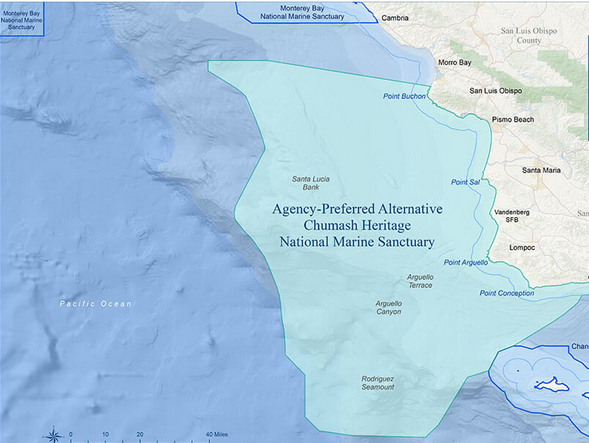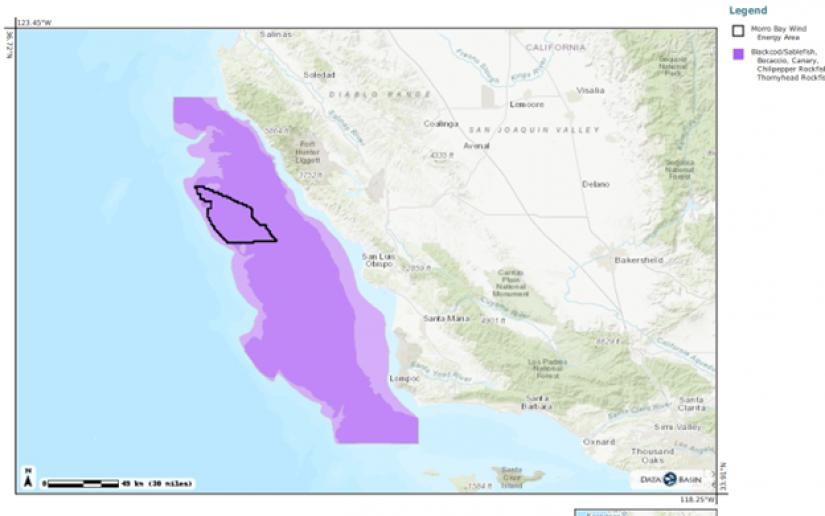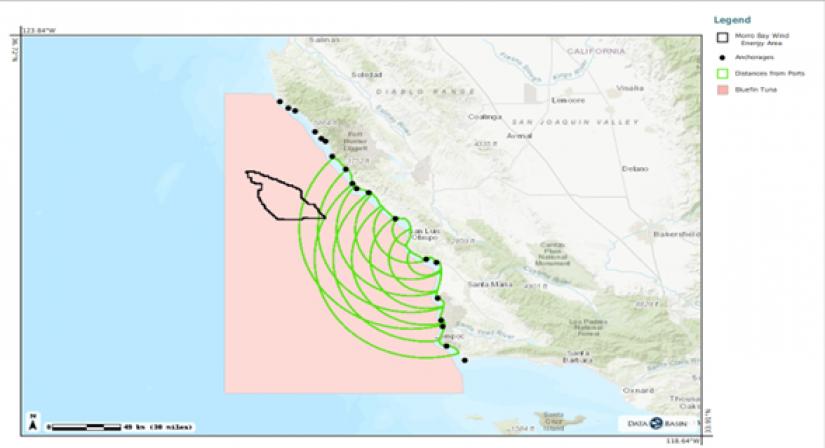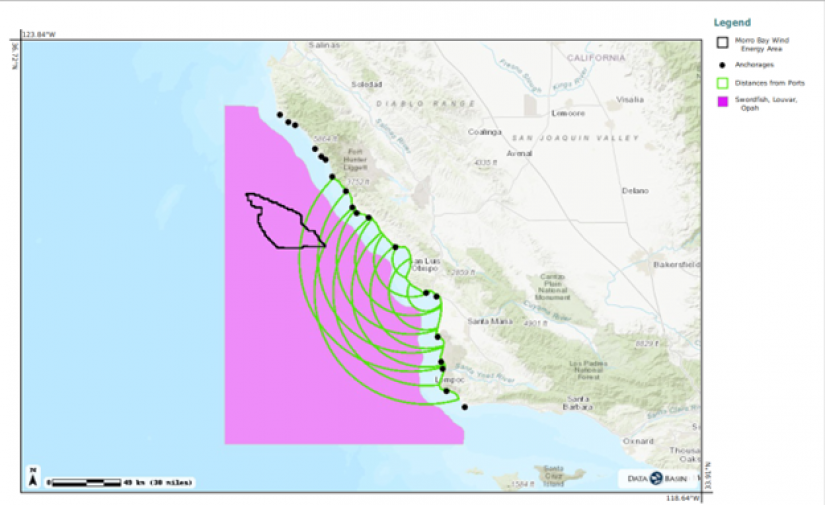Breadcrumb
- California Offshore Winds
- Marine Sanctuaries and Fishing
Marine Sanctuaries and Fishing
- What is the relationship between the Morro Bay Offshore Wind Energy Areas and a proposed marine sanctuary on the Central Coast?
The National Oceanic and Atmospheric Administration designates marine sanctuaries. According to NOAA, “the goal of the sanctuary system is to protect important natural and cultural places, while still allowing people to enjoy and use the ocean.” [1] Communities are invited to nominate sanctuaries. In July 2016, a consortium with leadership from the Northern Chumash Tribal Council requested a formal sanctuary designation. In 2021 NOAA published a notice of intent that it plans to designate 5,617 square miles of a sanctuary from Montaña de Oro State Park in San Luis Obispo County to Naples, California, along the Gaviota Coast in Santa Barbara County. The new proposed sanctuary would be the first new sanctuary since 1994 managed for biodiversity conservation. The Sanctuary would encompass submerged paleoshorelines with ancient indigenous village sites. The proposed designation differed from the original proposed boundaries and was no longer abutting the existing Monterey Bay National Sanctuary. There would instead be a space between Cambria and Morro Bay with no sanctuary designation.
Image
The Morro Bay Offshore Wind Energy Area lies outside the proposed Marine Sanctuary. The ocean space between Cambria and Morro Bay is one of the likely locations for underwater power cables. NOAA’s draft management plan does encompass the area surrounding Diablo Canyon but does not encompass Morro Bay or Morro Rock. This raises concerns for wind developers that there may not be enough grid connectivity in Morro Bay without upgrades to the presently 230 kV Morro Bay substation. [2] NOAA has not proposed regulating commercial or recreational fishing within the proposed sanctuary. [3]
- What are the fishery resources in Morro Bay Wind Energy Areas?
Based on data collected by the Morro Bay Commercial Fishermen’s Organization with researchers from UC Santa Cruz, the Morro Bay Wind Energy Area includes habitat for blackcod/sablefish, bocaccio, canary chilipepper Rockfish, Thornyhead Rockfish. Other fish present within the Morro Bay Wind Energy Area include blue fin tuna, swordfish, and thresher shark.



- Will Commercial Fishers be able to fish within the Wind Energy Area?
It may still be possible for commercial fishers to be able to fish within a Wind Energy Area. The United States Coast Guard (USCG) will conduct a Navigational Safety Risk Assessment as part of the wind area development to determine what interference there may be between wind farm infrastructure and users of air space, sea surface, water column, and seabed floor. The Bureau of Ocean Energy Management (BOEM) required wind developers in the Atlantic to work on a 1 mile by 1 mile grid turbine layout to ensure safe navigation of vessels through wind farms. BOEM cannot restrict vessel traffic but the USCG may require some safety buffers during construction. Commercial insurance companies may prevent vessels from fishing within wind farms using certain gear.
Certain types of fishing gear are not permissible within the Morro Bay Wind Energy Area because a sizable amount of the area is within the Big Sur Coast/Port San Luis Essential Fish Habitat Conservation Areas. These conservation areas are closed to bottom trawling.
Depending on spacing of turbines, certain types of fishing vessels may not be able to easily maneuver within a wind farm such as a fishing vessel with dredges or bottom trawl gear in those areas where the gear might be deployed.[6] Certain types of fishing gear including trawls, pot/traps, and nets may become entangled with wind infrastructure including mooring cables. Other types of fishing methods including hook-and-line gear may have less chance of entanglement. As of 2023, there were no U.S. studies that identified specific benefits (artificial reef effects), risks (difficult navigations), and costs (potential harm to gear) of harvesting within a wind farm. [5]
- What benefits may be available to impacted fishing families as part of offshore wind development?
Under the California leases, individual fishers may be able to access community benefit agreements for impacts associated with the lease area. Each of the wind developers has a fishery liaison who will work to compensate individuals whose fisheries resources use is impacted by wind development activities. There is no requirement for how these benefits are distributed but wind developers may propose creating a trust to benefit fishers.
The ability of fishers to adapt to any changes associated with offshore wind development has not been studied but will depend on the speed and scale of offshore wind development.
- Will recreational fishers be impacted?
Recreational fishers on both private boats and charters who fish for highly migratory species such as tuna in waters deeper than 200 meters may be impacted by the same navigational restriction rules that would apply to commercial fishers. Most recreational fishers in the Morro Bay and Humboldt Bay region do not fish in such deep waters.
- Will the infrastructure in the OSW farm increase biomass?
OSW platforms may be colonized by marine biomass such as shellfish. The infrastructure may operate like a “fish aggregating device” and attract fish. Concentrations of fish may attract predators such as sharks and seals.
- What are the fisheries resources in Humboldt Bay Wind Energy Area?
Like the Morro Bay Wind Energy Area, the Humboldt Wind Energy Area is located in the productive California Current System. Fisheries are important for Humboldt Bay and the value of all marine commercial fishing landings at the Eureka Port Complex (Eureka, Trinidad and Crescent City) between 2009 and 2018 averaged about $216 million per year. The most economically important commercial landing is Dungeness crab which accounts for about 22% of the value of the area’s fisheries.
Pelagic fisheries resources that might overlap with the Humboldt Bay Wind Energy Area include Pacific sardines, Pacific mackerel, Northern anchovy, market squid, jack mackerel, endemic krill, pacific herring, and jack smelt. Highly migratory species that may be in the wind energy area include North Pacific albacore, tuna, common thresher shark, shortfin mako, blue shark, striped marlin, swordfish, dorado, lancet fishes, louvar, and stingrays. Ground fish that may be present in the area include several species of skates, several species of rockfish including thornyheads, several species of sole, several species of grenadiers, pacific cod, sablefish, and greenlings. Pacific salmon including chinook salmon, coho salmon, and pink salmon may also be present. [6]
Potential fishing ground in the Wind Energy Area including sablefish, thornyheads, dover sole, albacore tuna, chinook salmon, and hagfishes. Fishermen have fished within the Wind Energy Area particularly for groundfish. Between the wind energy areas and commercial landing ports, fishermen fish for other valuable commercial fish including Dungeness crab, petrale sole, and ocean (pink) shrimp. [7]
- What are the wind development companies required to do to avoid impact on essential fish habitat?
To avoid damage to fisheries resources, the wind development companies are expected to avoid intentional contact with “hard substrate, rock outcroppings, seamounts, or deep sea coral/sponge habitat and to create buffers around these habitats when metocean (meterological oceanographic) buoys are being deployed during site characterization. The wind developers must explain how they will place anchors to the metocean buoys to avoid sensitive ocean habitats. Wind developers are also prohibited from bottom trawling during survey work including biological surveys. [6]
- References
[1] National Ocean Service, NOAA, Marine Sanctuaries, https://oceanservice.noaa.gov/ocean/sanctuaries/
[2] National Marine Sanctuaries, Submarine Cables in Olympic Coast National Marine Sanctuary: History, Impact, and Management Lessons https://sanctuaries.noaa.gov/science/conservation/submarine-cables-in-olympic-coast-nms.html
[3] Proposed Chumash Heritage National Marine Sanctuary Frequently Asked Questions, https://sanctuaries.noaa.gov/chumash-heritage/faqs.html
[4] Morro Bay Economic Impact Report, https://www.morrobayca.gov/DocumentCenter/View/7690/LWC_MB-Econ-Impact-Report-2014_Final?bidId=
[5] NOAA Technical Memorandum NMFS-NE-291, Fisheries and Offshore Wind Interactions: Synthesis of Science, National Marine Fisheries Service, Northeast Fisheries Science Center, Woods Hole Massachusetts (March 2023)
[6] Bureau of Ocean Energy Management, (2022) Offshore Wind Lease Issuance, Site Characterization , and Site Assessment: Central and Northern California, Table 12 https://www.boem.gov/sites/default/files/documents/renewable-energy/state-activities/Final%20CA%20Ren%20lease%20issuance%20BA_EFH_07222022_Clean_508%20compliant%20Final.pdf
[7] Bureau of Ocean Energy Management, Final Environmental Assessment, (2022) Humboldt Wind Energy Area, https://www.boem.gov/sites/default/files/documents/renewable-energy/state-activities/Humboldt-EA.pdf